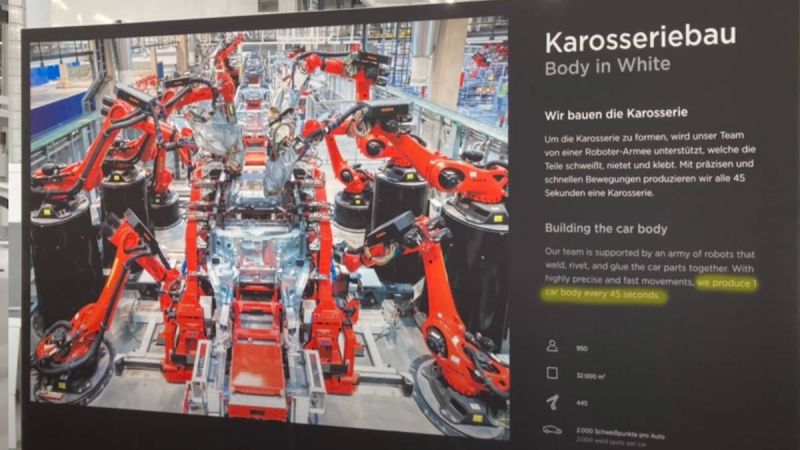Is Tesla Sandbagging Giga Berlin?
We can guess what Tesla's Giga Berlin factory and its capacity in the first year will be - it will be about 500,000 vehicles per year as Tesla has already stated from their Giga Berlin festival showing their Giga Berlin body line with one new Model Y body every 45 seconds. This is great and this is about 50% of the vehicles that Tesla delivered in all of 2021.
Elon Musk goes on to sustain this further and says that he hopes Giga Berlin will achieve sustained cycle time of 45 seconds. If you take a 75% uptime over an average week, that is about 10,000 cars per week if you run 24 hours a day. This equals to about 500,000 vehicles per year, with a capacity of about 700,000.
This seems quite similar to how Giga Shanghai started. In the past, we were told that the Model Y portion of the Giga Shanghai factory would have a capacity of about 200,000 vehicles. Yes, only 200,000 - however, at the time, that was exciting news for those invested in Tesla and their mission to accelerate the world to sustainable energy. Note, there was also a 250,000 Model 3 capacity in Giga Shanghai.
Giga Shanghai capacity now says over 450,000 for both of the factories in Giga Shanghai combined. My question is, why doesn't Tesla acknowledge that their yearly run rate for Giga Shanghai is much closer to 900,000 to 1 million vehicles as it is right now? And this is even with the supply chain issues where Tesla could produce much more if they weren't constrained.
This is the first clue that Tesla is sandbagging Giga Berlin - that is, they are promising a lot fewer cars than they will likely actually deliver. It makes sense for them to do this - prepare for the worst and hope for the best. You don't want to over promise and under deliver. Better to under promise and over deliver.
Giga Berlin Ramp Up
Giga Berlin will need less robots and processes than Giga Shanghai due to it using front die cast models. With this improvement, will Giga Berlin potentially reach 2 million vehicles per year - since Giga Shanghai has about a 1 million per year capacity for Model Y? Is it possible with all the new manufacturing equipment and techniques?
However, looking at the capacity of Tesla's factories may not be the best way to quantify future production. A better place to look for in how production will go for Tesla is the amount of batteries that Tesla has. For Giga Berlin, it will start with 2170 batteries, but will likely start using 4680 batteries later in the year, which will take the factory offline for a couple weeks.
The 4680 batteries will require a very specialized team of highly trained professionals and engineers to get working. If I were Tesla, I would try to find a way to simplify the 4680 battery process so that it didn't require such highly trained professionals. Get a system down of how these batteries are manufactured, put together, and connected and placed in the Tesla body.
What I think will happen is that for any complex processes, Tesla will very aggressively try to eliminate parts and processes that make the process complex. This is because simplicity is understandable by many more people than complex things. Which means, I think we'll see the current Giga Berlin factory reach around 1 million vehicles per year by the end of 2023 - without ANY expansion. This is a surprise waiting for those studious enough to see it.
My conclusion is that barring any global disasters, Giga Berlin production is being highly underestimated. Let's wait and see how it does after it opens!
Is Giga Berlin being underestimated? What will be the max yearly run rate of the current Giga Berlin production line (without expansion)?
Leave your comments below, share the article with friends and tweet it out to your followers.
Jeremy Johnson is a Tesla investor and supporter. He first invested in Tesla in 2017 after years of following Elon Musk and admiring his work ethic and intelligence. Since then, he's become a Tesla bull, covering anything about Tesla he can find, while also dabbling in other electric vehicle companies. Jeremy covers Tesla developments at Torque News. You can follow him on Twitter or LinkedIn to stay in touch and follow his Tesla news coverage on Torque News.











